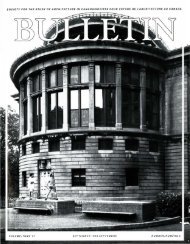CANADA - SEXTONdigital
CANADA - SEXTONdigital
CANADA - SEXTONdigital
You also want an ePaper? Increase the reach of your titles
YUMPU automatically turns print PDFs into web optimized ePapers that Google loves.
JACQUELINE H UCKER > ESSAY I ESSAI<br />
peace, and yet we labor to know what it<br />
is we hold on to.<br />
FI G. 2. WALTER ALL WARD, VI MY MONUMENT, 1936.<br />
that one day all would be forgotten.<br />
Rudyard Kipling's invocation, ' Lest we<br />
forget' was written for another conflict,<br />
but it came to serve as a clarion cry for<br />
the Great War and its aftermath.<br />
We know that time engenders forgetfulness<br />
that can heal even the most terrible<br />
loss 2 Yet, despite the passing of the First<br />
World War generation, the landscape of<br />
the Western Front retains its hold on the<br />
present. Sometimes, a poignant personal<br />
message breaks free of its stone, and infuses<br />
the silence w ith sadness . At other<br />
times, the clear light of a late afternoon<br />
might reveal the outline of an old trench<br />
line cutting across a field, and a shadow<br />
falls across the present. And, always, the<br />
rusted remnants of war debris are breaking<br />
through to the surface, a reminder<br />
of the brutal nature of that struggle. It<br />
seems the First World War cannot rest in<br />
The Vimy Monument is part of this<br />
world . Rising from the highest point<br />
of Vimy Ridge, it forms the centrepiece<br />
of a carefully preserved section of the<br />
western front, 14 kilometers north of<br />
the town of Arras in the Pas de Calais<br />
region of France (fig. 1). The 100-hectare<br />
site' was granted to Canada in perpetuity<br />
by France in 1922 to be preserved<br />
as a memorial park "to the memory of<br />
the Canadian soldiers who died on the<br />
f ield of honour in France during the war<br />
1914-18". 4 The memorial park is Canada's<br />
principal monument in Europe to the<br />
country's contribution and sacrifice in<br />
the First World War. The names of 11,285<br />
Canadian servicemen who died in France<br />
and have no known grave are engraved<br />
across the monument's outer walls (fig. 2,<br />
4). There are also two cemeteries within<br />
the boundaries of the park; one contains<br />
the graves of 111 Canadian soldiers who<br />
died during the Canadian offensive to<br />
capture the ridge on April 9-12, 1917; the<br />
other is a collector cemetery containing<br />
the bodies of 2, 965 Allied soldiers, including<br />
695 Canadians, who died on<br />
the ridge between 1914 and 1918. The<br />
site also includes a significant length of<br />
the Canadian and German front lines<br />
and tunnel systems as they existed in<br />
April, 1917. W ith the dramatic drop of<br />
its northeast slope, the section of ridge<br />
within the park also provides clear evidence<br />
of why Vi my Ridge was so militarily<br />
significant during the First World War<br />
and why its capture is considered to be<br />
one of Canada's greatest accomplishments<br />
of that conflict. The memorial park<br />
is, in fact, a capsule of the Western Front,<br />
preserving evidence of the war itself and<br />
its consequences, as well as Canada's<br />
commemorative response. The park also<br />
provides a dramatic setting for ongoing<br />
ceremonies of remembrance. Although<br />
40<br />
JSS AC I JSE AC 33 > N' 1 > 2 008
















